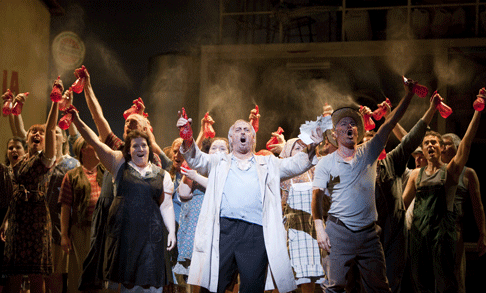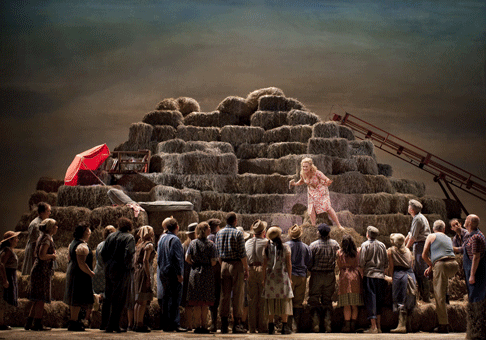Laurent Pelly’s 2006 staging, first seen at Covent Garden in 2007 and
revived here by Daniel Dooner, certainly supplies much absurdity,
capriciousness and inanity, but it is rather lacking in genuine warmth and
tenderness. In this ‘busy’ staging, characters are entertaining but
not fully engaging; we smile gently at their follies and witticisms, but they
don’t truly touch our hearts. We don’t really care; and, it seems,
neither do they. The humour is largely visual: indeed, on the opening night the
largest laughs were raised by the manic terrier which intermittently whips
across the stage, and by the between-scenes front cloth advertising Doctor
Dulcamara’s entire range of miraculous potions and lotions – the clutter
of cures for Constipazione and Impotenze recalling an email
inbox, deluged by SPAM offering fake Viagra.
Striving for a realism that would put many a verismo production to
shame, Pelly furnishes his stage with a relentless assemblage of period props
— tractors, lorries and Vespas — to evoke rural, post-war Italy.
The curtain rises on a precipitous mound of hay-bales. It’s true that
this Nemorino — a foolish bumpkin — certainly has a mountain to
climb if he’s to win the hand of Diana Damrau’s feisty, spoiled
Adina. While the workers toil in the sun-drenched fields, the queen bee perches
aloft, preening herself beneath her pink parasol, laughing disdainfully at
tales of ‘real’, un-dying love of the kind that will later catch
her unawares.
No-one could accuse Giuseppe Filianoti of lack of commitment: as Nemorino
he, literally, throws himself into the part, hurling himself around the stage
like a hyperactive child, tumbling and flailing in a hopeless effort to catch
the eye of the indifferent Adina. When Dulcamara declares that he met a few
fools in his time but none quite as dim as Nemorino we are inclined to nod in
agreement. While this self-deprecating slapstick raised a few chuckles, it did
not distract from Filianoti’s vocal weaknesses. His is a dark-toned
tenor, but the upper range is strained and reedy, and his opening number was
particularly uncomfortable. In the Act 1 finale he seemed completely adrift,
musically and dramatically. Despite these problems, there were moments to
admire. Filianoti’s diction is excellent, he uses the words well, and his
performance did improve as he slowly warmed up. He certainly conveyed
Nemorino’s ardency and sincerity in the Act 2 ‘Una furtiva
lagrima’. Yet, it was rather an effort, and the simple elegance required
to communicate the profound, ‘poetic’ sensibility to be found
beneath the buffoon’s clownish exterior was lacking.
As Adina, the German soprano, Diana Damrau, commands the stage. Dressed in a
seductively low-cut dress (costumes are by Chantal Thomas), she flirts and
flaunts, incessantly prancing, posing and pouting. However, while she entirely
lacks innocence and does not really earn our sympathy, she can be forgiven for
these exaggerated excesses as she renders Donizetti’s lyrical melodies
and capricious coloratura with delicious beauty and ease. Outraged by the
attention that Nemorino’s new-found wealth garners from the other girls,
Damrau’s fiery fioratura is flawless. And, her declaration of love – a
stunning two-octave plunge sealing her promise to make him ‘as happy as I
used to make you miserable’ – is the high-point of the evening.
 Simone Alaimo as Dulcamara and The Royal Opera Chorus [Photo by Johan Persson courtesy of The Royal Opera House]
Simone Alaimo as Dulcamara and The Royal Opera Chorus [Photo by Johan Persson courtesy of The Royal Opera House]
The Sicilian bass-baritone, Simone Alaimo, played Dulcamara as if this was
his five-thousandth performance of the role … perhaps it was. His
buffo gestures were rather tired; even the chorus, who excitedly
anticipated his entrance, didn’t wait around to hear his sales pitch
— leaving Alaimo addressing an empty stage. A sharp, red suit in Act 2
enlivened him somewhat; responding to Adina’s confident assertions that
the power of her own physical attributes is more than a match for any elixir
Dulcamara cares to offer, he demonstrated more energy and sparkle. But, Pelly
seems to view the quack doctor less as a loveable rogue than as a greasy
slime-ball. Like Anthony Michaels-Moore’s cock-sure Sergeant Belcore, he
is presented as a cynical opportunist. In Belcore’s opening aria, despite
standing aloft the hay-bales, a ‘king of the mountain’,
Michaels-Moore struggled to project his baritone; he was a rather
one-dimensional figure throughout, a charmless bully. The Japanese soprano, Eri
Nakamura, supplied the evening’s one genuine moment of sweet, unaffected
tenderness, as Giannetta.
Pelly’s direction of the chorus is confusing and over-emphatic. At
times, they are uncompromisingly involved in the action, was in the opening
scene when they taunt and torment Nemorino with an alarming aggression!
Elsewhere they ignore the action entirely, and face forwards, immobile, to
address the audience — a gesture which lacks subtlety, relevance and
becomes increasingly irritating.
 A scene from L’elisir d’amore [Photo by Johan Persson courtesy of The Royal Opera House]
A scene from L’elisir d’amore [Photo by Johan Persson courtesy of The Royal Opera House]
Despite Pelly’s desire for realism, this production does not truly
convey the dark side of the drama – the potential sadness, even tragedy, hiding
behind the comic frills, or the cynical exposure of the true elixir of love:
money. Fortunately, Bruno Campanella understands the aesthetics of bel
canto, and he stylishly controlled the colour and pace of the performance
from the pit.
So, in this visually catchy production there is lots to entertain and much
to admire, but perhaps rather less to enchant.
Claire Seymour
image=http://www.operatoday.com/ELISIR-2009_00883-DAMRAU-AS.gif
image_description=Diana Damrau as Adina and Giuseppe Filianoti as Nemorino [Photo by Johan Persson courtesy of The Royal Opera House]
product=yes
product_title=Gaetano Donizetti: L’elisir d’amore
product_by=Adina: Diana Damrau; Nemorino: Giuseppe Filianoti; Dulcamara: Simone Alaimo; Belcore: Anthony Michaels-Moore; Giannetta: Eri Nakamura. The Royal Opera. Conductor: Bruno Campanella. Director: Laurent Pelly. Costume Designs: Laurent Pelly. Set Designs: Chantal Thomas. Lighting: JoÎl Adam.
product_id=Above: Diana Damrau as Adina and Giuseppe Filianoti as Nemorino [Photo by Johan Persson courtesy of The Royal Opera House]